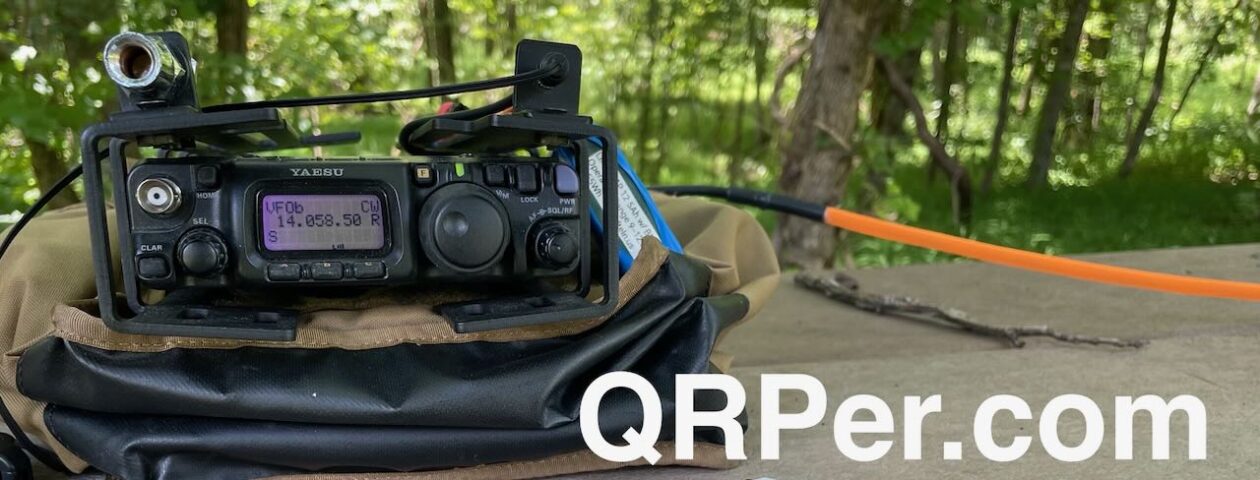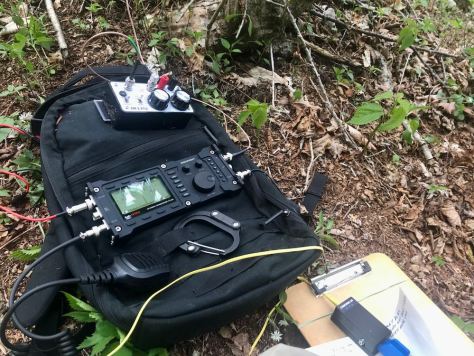 I learn a lot about a radio the first time I take it to the field. I’m not sure if it’s because being out of the shack helps me give it my full attention, or if it’s because field conditions vary and this allows me to see how flexible and adaptable the radio is.
I learn a lot about a radio the first time I take it to the field. I’m not sure if it’s because being out of the shack helps me give it my full attention, or if it’s because field conditions vary and this allows me to see how flexible and adaptable the radio is.
On Monday (May 17, 2021), I was eager to hit the field with a new-to-me radio.
The previous week I didn’t log even one park or summit activation. Typically I’d hit at least two. There were a couple of reasons for this…
First, we had a fuel shortage in western NC and I didn’t want to burn any extra fuel for activations knowing we had some important family errands that week.
Secondly, I needed to hunker down and finish a number of projects I’d been working on including a lengthy two-part field radio kit feature for The Spectrum Monitor magazine, and a new in-depth TX-500 review for RadCom. FYI: Part one of my feature for TSM will appear as the cover article in the June 2021 issue.
We also had a number of family projects to sort out. So a week at home perfectly timed with the fuel shortage.
The new radio
I collect reader and viewer suggestions and when I see that there’s a radio or product, in particular, folks would like to see tested, I try to obtain one.
One of the most requested radios lately has been the Xiegu X5105.
A number of readers have asked me to obtain an X5105 and take it to the field. Many are considering purchasing this (incredibly) affordable full-featured QRP transceiver, others own it, love it, and want to see how I like it compared with my other radios.
Last year, I came very close to purchasing the X5105 for review, but opted for the Xiegu G90 instead (here’s my review of the G90).
Even though the X5105 is only $550 US, I really didn’t want to make a purchase at this point because I’m budgeting for a new MacBook, new video camera, and I just purchased the TX-500.
So I reached out to Radioddity who is a sponsor over at the SWLing Post. I’d been in touch with Radioddity a lot as of late because I’ve been evaluating and testing the Xiegu GSOC for the past few months. They lent me the GSOC (and a G90 because I sold after my review) and I was in the process of packing up both units to send back to them.
I asked if they could lend me an X5105 for a few weeks. They were quite happy to do so and dispatched one in short order.
A clear relationship
Side story…
Back when I decided to place ads on the SWLing Post and QRPer.com, I worried about any inherent conflicts of interest. I read magazines that review products and can tell that they’re being gentle in their criticism because there’s a two page ad of the product immediately following the review. I don’t like that.
This conflict is something that’s almost inevitable with any radio publication that grows to the point of needing monetization to support it.
I made a few Golden Rules up front:
1.) I would only place radio-relevant ads on my sites. Period.
2.) My ads and sponsorships would be hand-picked and by invite only. I choose who can be a sponsor.
3.) I’m up-front with sponsors that my reviews call it like it is. If they send me product to review, I will give it an honest evaluation based on real-life use. If I don’t like it or can’t recommend one of their products, I’ll let my community know.
I’ve lost a couple of sponsors over Golden Rule #3 over the years. I’m okay with that because I’d rather not allow an advertiser on my site that can’t take customer criticism.
I invited Radioddity to be a sponsor of the SWLing Post last year after I had some positive interactions with them.

Radioddity sent me the new GSOC to review in November 2020. I discovered in short order that the GSOC had some major issues and, frankly, I didn’t like it and certainly couldn’t recommend it. I communicated my concerns about this product with detailed notes and suggestions for improvement. I was open and honest about the GSOC on the SWLing Post (read the thread here).
Radioddity not only embraced my criticisms but sent them to the manufacturer and thanked me.
Impressive.
Blue Ridge Parkway (K-3378)
But back to the activation!
So on Monday, May 17, I had an errand in town that took me right past the Blue Ridge Parkway Folk Arts Center. The detour to do an activation was maybe two minutes, so there was no “fuel-shortage” guilt! 🙂
Also, I had a good hour to burn before I needed to go home and pack for a quick trip to visit my folks.
Equipment list:
- Xiegu X5105
- Packtenna 9:1 UNUN Random Wire Antenna
- CW Morse “Pocket Paddle”
- GoRuck Bullet Ruck
- Hardened Power Systems QRP Ranger
- Arborist throw line
- Rite In The Rain Weatherproof Cover/Pouch (affiliate link)
- Muji A6 Notepad (affiliate link)
I deployed the PackTenna 9:1 random wire antenna specifically because I wanted to see how easily the X5105’s internal ATU could match it.
I hopped on 40 meters first, hit the ATU button and it quickly found a 1:1 match–good sign!
This turned out to be a pretty easy and simple activation.
I started calling CQ and within 12 minutes I logged 11 stations.
I moved up to 20 meters knowing it would be a tougher band, but worked one more station–KG5OWB at K-0756–pretty quickly.
I was quite happy with logging 12 stations in short order. A nice contrast to recent activations where conditions were so poor it’s been a struggle to get even 10 contacts within an hour.
I would have stayed on the air longer but (as I mention in the video) I wasted a good 20-25 minutes waiting on the landscape crew to finish mowing on/around the site before I set up my station. I didn’t want to be in their way.
Here’s my log sheet from the POTA website:
 Video
Video
Of course, I made one of my real-time, real-life videos of the entire activation. I’ve quite a long preamble in this one, so if you’re interested in skipping straight to the on-the-air time, go to 16:24.
X5105 initial thoughts?
So far, I like the X5105. It certainly accomplishes its goal of being an all-in-one “shack in a box.”
I performed this activation only using the X5105 internal battery. In addition, the ATU worked perfectly with the random wire antenna.
I like the size–it’s much smaller than I imagined. It’s also fairly lightweight.
 It feels rugged, too–I wouldn’t be concerned about it getting easily damaged in the field.
It feels rugged, too–I wouldn’t be concerned about it getting easily damaged in the field.
The speaker works pretty well, but if the volume level is pushed too hard, it starts to splatter. I wish it could handle a little more volume before the splattering kicks in.
The ergonomics are pretty good. It didn’t take long to sort out how to use most of the functions.
One area for improvement? The owner’s manual. It’s poorly written and (frankly) reads as if it was rushed to print.
For example, I wanted to set up CW memory keying prior to hitting the field. Unfortunately, the owner’s manual was no help.
There’s actually a dedicated page regarding CW memory keying, but the first thing it does is reference a different section of the manual (without giving a page number). I followed the procedure, but it didn’t work. In fact, it didn’t make sense as it seemed lead me down the path of digital mode macros. I think the manual may be referencing a procedure before the last firmware update (which, it appears, changed the menu structure significantly).
If you can help guide me through setting up CW memory keying, please comment! I’m sure it’s a simple process, but I haven’t sorted it out yet.
Overall, though? I see why the X5105 is so popular. It appears to compete with a loaded Elecraft KX2. It’s a bit larger, heavier, and less “refined” but it’s also half the price of a loaded KX2.
I also think it’s a great radio for CW operators. The keying feels natural and responsive. It uses relays instead of pin diode switching, so QSK includes a little relay clicking. I don’t find it to be too loud, though.
I’ll be taking the X5105 out again very soon. I’ve got it for 6 weeks, so it will get plenty of park and summit time. If you own the X5105, I’d love to hear your comments on this portable rig.
Thanks for reading!


























































































